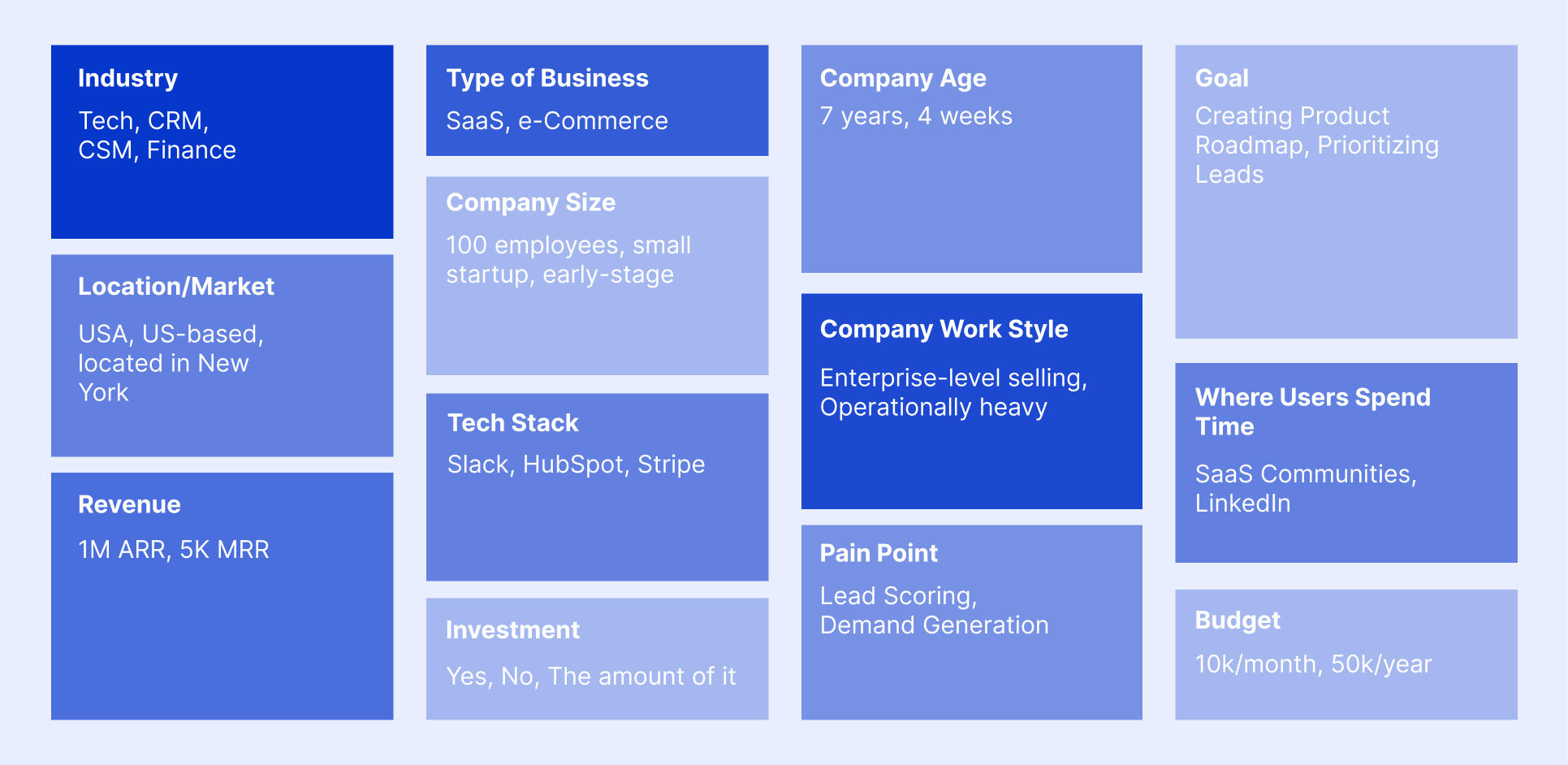The goal of this article is to show you how to identify your ideal customer profile (ICP), with actionable examples, templates, tools, and resources from experts.
TL;DR
- Narrow down your ICP. Focus on company attributes at first, and get as specific as possible.
- Add unique attributes and characteristics for further specification of your ICP.
- Identify your user and buyer persona to understand who really is your lover, and who is giving their precious money.
- Out of a cohort of 10, at least 1 person might have gotten some value. Let’s call them a “golden goose”. Now you go and find more than 10 people that fit the “golden goose” profile.
- No worries, your first ICP is not meant to be your last.
- Pay attention to your super users while refining your ICP.
- Do more customer interviews. More and more.
- Keep testing; pay attention to the signs and metrics.
- We all do have 0 months. Do not push hard. If there is someone willing to buy from you, but not fit in your ICP, still sell.
- Do we need multiple ICP profiles? Not every time. Go for simplicity and try to go with the fewest number of ICPs as possible.
- Always analyze intent (buying) signals to create and refine your ICP, not just for closing a single deal.
- The concept of an ideal customer profile can be subjective and vary depending on the industry.
Part 1: Introduction
We are getting so obsessed with our business idea that spend all of our time validating the problem and solution, we ignore to whom we are developing a solution and selling. Mistake number one: not identifying the right person to sell.
The wrong person won’t understand fully your idea as they cannot relate to it. But the right person can even move you in a better direction.
The goal of this article is to show you how to identify your ideal customer profile (ICP), with actionable examples, templates, tools, and resources from experts.
Part 2: What is Ideal Customer Profile (ICP)?

Ideal customer profile (ICP) means the perfect customer for your business. It refers to a customer with the highest potential to use your product, more likely to convert into a paying customer and stay with you for a long time.
We sometimes call it the ideal account profile, as it is more about account-level identification in B2B ideal customer profile.
So, keeping these in mind, we can say that it is to identify and prioritize perfect profiles.
Initial ICP is identified based on several different factors, like company size and industry (I’ll tell more about this part in the following sections), while if you have a customer base already, their behaviors and purchase patterns take a more important role in the identification process.
Let’s take it from the beginning simply: when a new possible customer engages with your product or content, they are measured against this Ideal Customer Profile (ICP), which has already been set up. This evaluation helps you figure out if this possible customer has the same traits and qualities as your dream customer.
Ideal Customer Profile vs. Buyer Persona
These two terms are different things. There are several main points they understand the difference between ICP and buyer persona:
| Focus | Level of Detail | Purpose | Characteristics | |
|---|---|---|---|---|
| ICP | Represents characteristics of the perfect customer for a business. | Gives an overview of customer groups at a high level, with a focus on broad traits and trends. | Serves as a strategy guide for making sure that marketing efforts are aimed at the right people. | Involves demographics, psychographics, and behavioral traits that align with products or services. |
| Buyer Persona | Gives a complete picture of a single customer within the ICP framework. | Level of Detail | Gives the ICP more depth and detail by putting the focus on individual users. | Allows businesses to make marketing strategies that are specific and personalized. |
Despite their differences, it is important to understand each to give direction to marketing and sales activities.
While ICP gives direction to all strategies and helps improve marketing and sales platforms, messages, and placement, understanding buyer persona helps you to make those efforts personalized and create meaningful conversations.
Why You Should Identify Your ICP?
It is not only about knowing your perfect customer, of course. It makes no sense alone, in an Excel document or slides. Identifying your ICP is like a power unit for your marketing, sales, customer success, and GTM teams.
When used correctly, there are some important reasons why your B2B SaaS businesses need ICP:
- Targeted and effective SaaS marketing campaigns
- High-quality potential buyer lists with high potential to convert for SDRs, MDRs, and ADRs
- Well-designed ABM campaigns to reach the right buyers at the right time
- Faster qualification and sales cycles with the right targets
- Increased return on investment (ROI)
- Developed product-led sales strategy
- Increased brand awareness
- Data-based product development
- Improved and targeted content marketing strategy with value-driven pieces of content
- Better customer lifetime value (CLV) rates with meaningful customer relationships
- Qualified targets, quality leads, and real revenue
Targeting the right persona touches every aspect of your business, not limited to those above, but most importantly, it lets you identify where the lead is in your funnel, and what they are looking for and it lets your marketing and sales team work collaboratively on them.
When sales and marketing teams work together, businesses see a 27% faster profit growth.
How Do You Use ICP for Your B2B SaaS?
As I mentioned in Why You Should Identify Your ICP, it isn’t just a theory; it’s also a tool that can be used to drive marketing strategies, improve sales, and help shape product development.
ICP has an important role in predictive lead scoring for both marketing and sales, as well as affects a product-led growth strategy.
In this part, we’ll talk about practical steps, insights, and strategies for putting ICP to good use in your business.
For Marketing
To optimize your lead score in marketing, you need to know what your ICP is. By knowing what your ideal customer looks like, marketing teams can put leads that match the ICP at the top of the list.
This makes sure that marketing efforts are focused on the best prospects, which can increase conversion rates and return on investment (ROI) a lot.
Knowing your dream customer, how would you act in marketing?
- Focus your marketing efforts on addressing the unique needs and preferences of your dream customer
- Personalize your marketing messages and strategies
- Take personalization to the next level by customizing your efforts on an individual or account basis
I don’t have to tell the rest because, after these steps where ICP is implemented, you’ll have a good deal of leads to give to sales.
For Sales
Using ICP for lead scoring in sales lets salespeople focus their efforts on prospects who are the closest matches to the ideal customer description. This makes sure that the sales team spends more time talking to high-quality leads that are more likely to become customers. It eventually improves sales cycles and makes it more likely that deals will be closed.
You have your ICP in your hand, what to do next?
- Build custom prospecting sequences
- Create industry-specific sales materials
- Identify key buying signals for your ICP and set up automated alerts
- Build a lead scoring system based on ICP benchmarks
For Product-Led Growth
In product-led growth, the product is the main thing that brings in customers, keeps them, and helps the business grow. The most important part of this method is to find and detect your ICP to position your product accordingly.
By matching product development and features to the wants and pain points of your ideal customer, you can make a product that effectively attracts and keeps people who find the most value in your solution.
This connection helps not only to get more people to use the product but also to improve customer happiness and value over time.
But, how it exactly works?
- A new user signs up
- Their data is measured against your ICP
- “In PLG, the true ICP evaluation can only be possible after the user spends some time in the product and made progress in their free trial. We were trying to qualify every user signed up for our free trial, yet we later found out that their first behaviors and usage patterns are actually the main indicators that reveal their fit.”
- Your product-led onboarding process is personalized based on it
- The lead is treated with the necessary help if needed
Part 3: How to Identify Your ICP?
Every business has its own way of identifying ICP. Yet, in most (almost all) processes, there are several common practices that you can also start from. (It is up to you to change your approach and create your way.)
Here is the ideal customer profile worksheet and templates we created for you to use in your business, including the customer profile template/buyer personas template and buying signals cheat sheet.
Collect objective market data
Market research, not for the product side, but for the other side of the mirror, CUSTOMER, is the first step to identifying your ideal customer profile. Yes, it is similar to customer research.
You might be asking “Why?”. Because the voice of the customers and the market will give real and objective data to get started.
Write down some questions, and try to find relevant answers from the market.
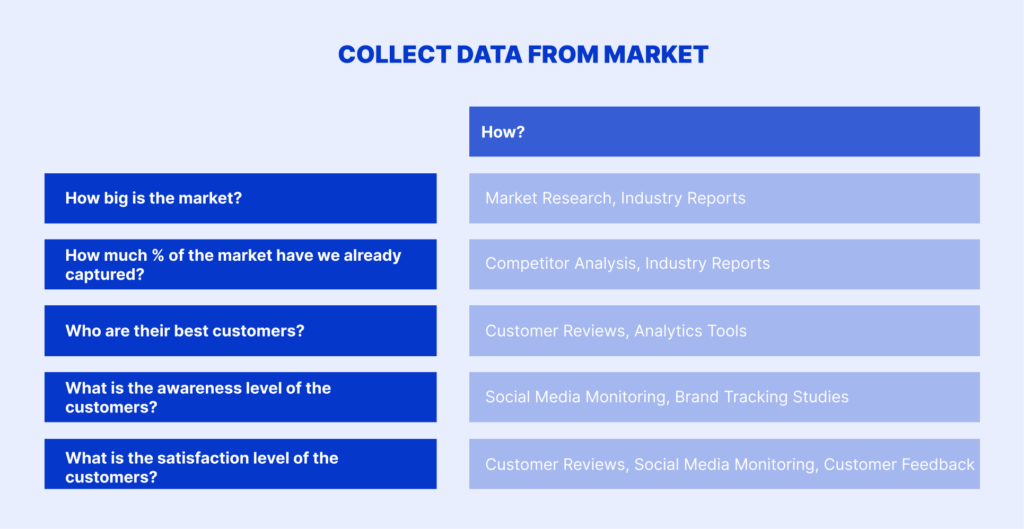
- How big is the market?
- How much % of the market have we already captured?
- Who are their best customers?
- What is the awareness level of the customers?
- What is the satisfaction level of the customers?
Start narrowing down the basic characteristics of your ICP
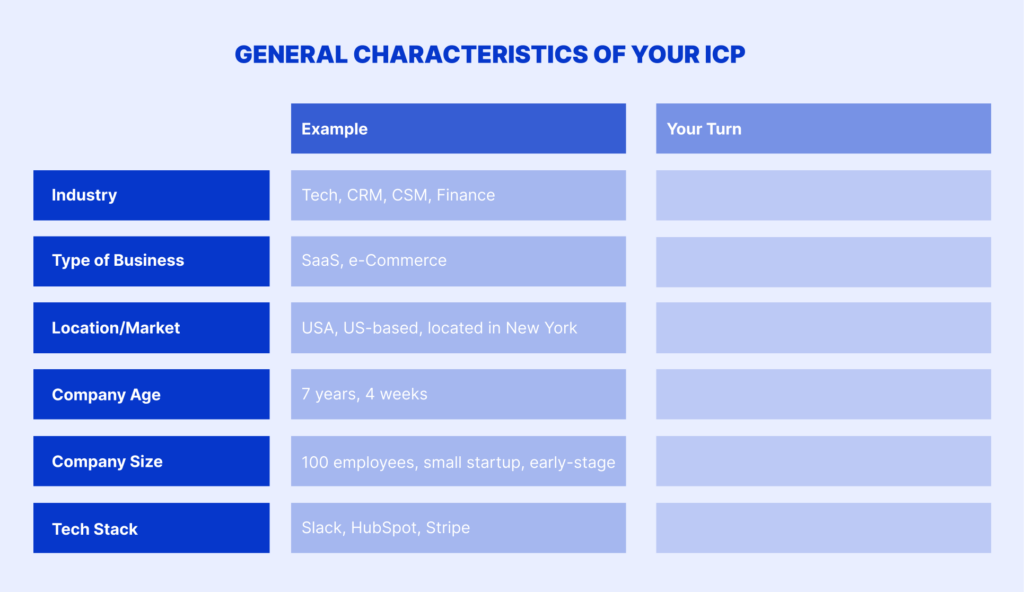
- Industry/Specialization (Tech, CRM, CSM, finance, health, product management, etc.)
- Type of Business (SaaS, software, B2B, B2C, e-commerce, etc.)
- Location/Geography/Target Market (USA, UK, US-based, located in New York, etc.) (Can be narrowed down)
- Company Age (7 years, 4 weeks, etc.)
- Company Size (100 employees, small startup, early-stage, etc.)
- Tech Stack (Slack, HubSpot, Stripe, etc.)
Start getting specific about the unique and important characteristics of your ICP
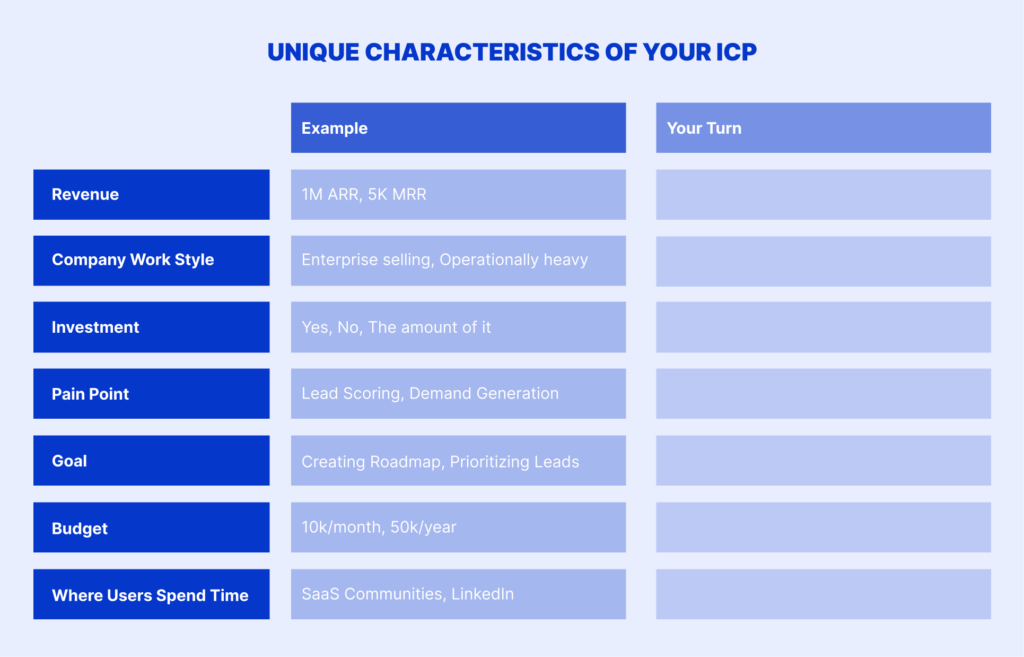
- Revenue (1M ARR, 5k MRR, etc.)
- Company Work Style (Enterprise-level selling, operationally heavy, etc.)
- Investment (Yes, No, the amount of it)
- Pain Point/Challenge (Social media management, lead scoring, demand generation, internal communication, etc.)
- Goal (Creating product roadmap, prioritizing leads, etc.)
- Budget (10k/month, 50k/year, etc.)
- Where User Spends Time (SaaS communities, Reddit, etc.)
Now you have the general and unique characteristics of your ICP, you can start working on your User and Buyer Persona
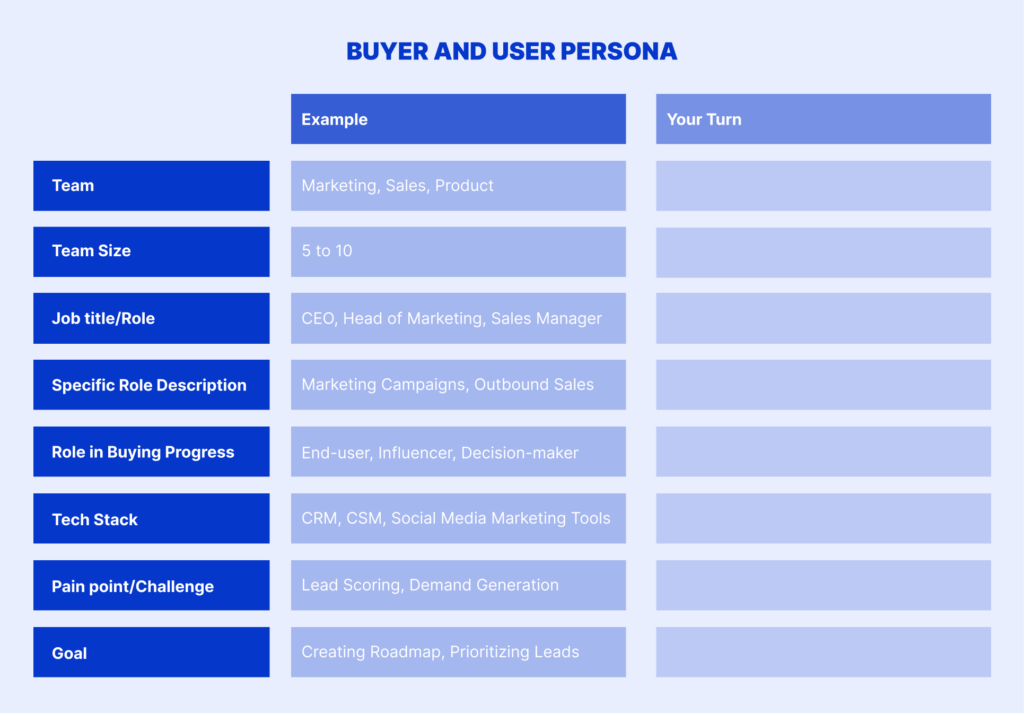
- Team (Marketing, sales, product, etc.)
- Team Size (5 to 10, 10+, etc.)
- Job title/Role (CEO, head of marketing, sales manager, etc.)
- Specific Role Description/Function (Running marketing campaigns, content marketing, outbound sales, etc.)
- Role in the Buying Progress (End-user, Influencer, Decision-maker, Economic Buyer, etc.)
- Tech Stack (CSM, CRM, Marketing Tools, etc.)
- Pain point/Challenge (Social media management, lead scoring, demand generation, internal communication, etc.)
- Goal (Creating product roadmap, prioritizing leads, etc.)
Test your initial ICP for 1 to 6 months
Identifying your ICP is not a one-time work. You should test the effectiveness of your ICP for some time, from time to time (depending on the company and business), and analyze some metrics and indicators:
- Conversion rate
- Time to Value
- High NPS score
- Key attributes
- Increase in product usage
- Inbound customers interacting with you
Signs you’re doing great
- Increased conversion rate
- Higher win rate
- Increased satisfaction
- High LTV
- High NPS score
- Happy customer interviews, or communications
If you fail, don’t worry. Start paying attention to your super users (best customers), not the leads that try to pull with hassle
In the testing period, you’ll collect relatively good data to understand how the reality matches your plan.
Don’t worry, it sometimes has differences, actually, is most of the time. So, the important action you’ll take here is to focus on your super users and higher rates.
Review their geographics, demographics, psychographics, and behavior.
Focus the your win rate, LTV, and NPS in different segments.
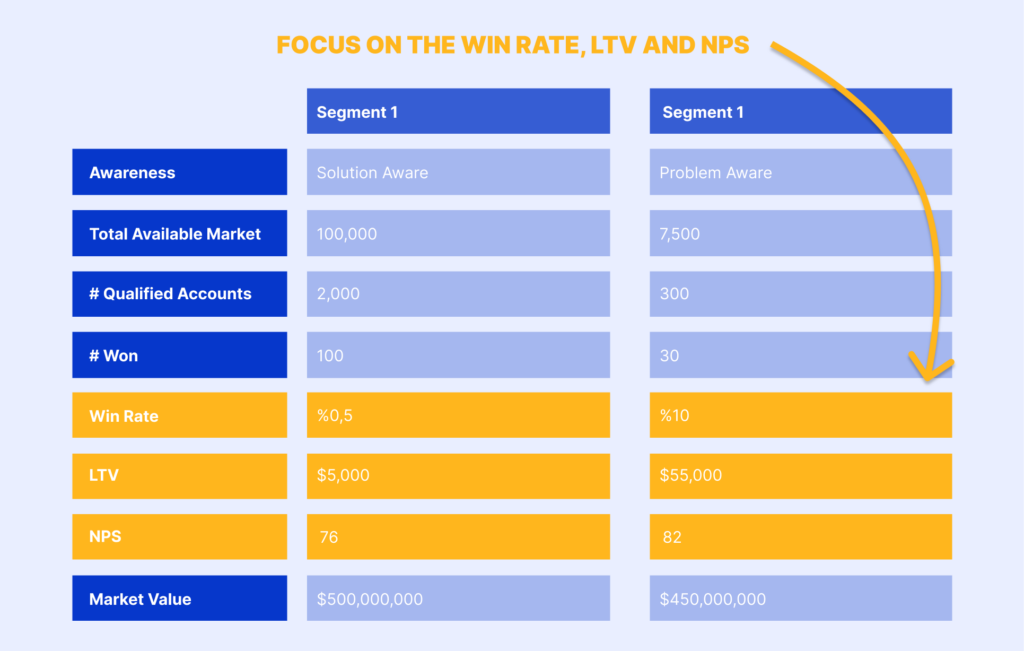
Refine your ICP based on data analysis patterns, and feedback in successful deals
When you identify your super users, you’ll get a bunch of data, right? You’ll have feedback (because super users are more willing to give you some), and also data, and patterns into those processes.
The role of customer feedback in refining an ideal customer profile cannot also be overshadowed as it highlights the importance of gathering and incorporating customer feedback to continuously improve the ICP.
You will use that data to refine your ICP and implement it into your GTM strategy immediately, by going through a positioning exercise:
- What were their pain points?
- What were their goals?
- At what stage in the buyer’s journey did they encounter our positioning?
- Why they have chosen my product rather than others?
- What are the outcomes that people in my ICP have achieved?
Sell to whoever buys, when all your plan goes for nothing
If it is still not working as expected, focus on who you can sell this month. There is no harm in this. At some point, when you repeat those processes, you will find its final and successful version. But still, it will be refined again.
Let’s continue with checking all points to never miss any part of the process
Ideal Customer Profile (ICP) Checklist
[ ] Collect objective market data
[ ] Narrow down with basic characteristics of your ICP
[ ] Get specific about the unique and important characteristics of your ICP
[ ] Identify your User and Buyer Persona
[ ] Test your initial ICP for 1 to 6 months
[ ] Focus on your super users
[ ] Focus the your win rate, LTV, and NPS in different segments
[ ] Refine your ICP based on feedback, data analysis, and observed patterns in successful deals
Part 4: Ideal Customer Profile Examples from Today’s SaaS Companies
Through my research, I’ve read, listened to, and asked about the experiences of SaaS companies with identifying ICP, testing it, refining it, and more.
Each has a different experience in a different stage, and I collected the most helpful ones for you. (Read the full interviews here)
Identifying initial ICP, narrowing down the basic characteristics of the Company
Userlist’s positioning shaped their initial ICP:
“We’ve been running Userlist since 2017. At the moment, we position it as an email marketing platform built specifically for SaaS companies. (You can see the whole history of our positioning statements.)
Originally our goal was to meet the needs of early-stage founders, as there was a clear lack of such tools in the market.
Therefore, we identified our ideal customer profile as:
- Larger SaaS companies
- Marketers, possibly Head of Marketing or Head of Growth
- Companies overhauling their user onboarding or switching to a product-led model
- Companies running into limitations with their previous email provider
That’s when they’re ripe for switching to Userlist.”
– Jane Portman, Сo-founder & CEO of Userlist
Ferhan Gul shared their experience with two SaaS products:
“For three years, I managed two different SaaS products. The product underwent both minor and major modifications during the course of three years. Everything from feature development to pricing is altered in this process.
Our ICP did not undergo major changes from the moment we first launched the product to the first 12 months, but we did have to make medium-scale changes.
Our first goal was to sell the product to the team belonging to the target departments in the companies, but since our ICP did not support this comfortably, we decided to expand our target with the target number of employees.”
Ferhan Gul, Product & Growth
THINKIN identified their own characteristics first:
“We built THINKIN primarily for ourselves, so our first ICP was “people like us”. For the ICP, we looked at what do we all have in common and which are the characteristics that contribute to ICP and which ones don’t, like you would do in a regression analysis. Our initial ICP was:
And Brill, Founder & CEO at THINKIN
- People in their late 20s/early 30s who live abroad,
- In Tier1 cities,
- Learned at least four languages throughout school and college
- Like to travel, career involves international travel.”
Gong has shared what a typical sales ICP should look like:
“In the typical sales ICP, the attributes that should be considered are:
– Gong, ICP Sales
- Industry
- Revenue
- Employee Count
- Geography
- Key Challenges
- Tech Stack
The initial ICP is like a learning process, according to Dock:
“Part of this was a learning process.
At its core, Dock serves as a workspace where two companies can collaborate. This is somewhat vague as a value proposition.
Over time, we discovered that salespeople and those in customer success experienced the most significant challenges when collaborating with individuals outside their company.
Our initial ICP was somewhat ambiguous, targeting anyone who interacts with people outside their company. We anticipated a focus primarily on individuals within a revenue team, which might encompass those in marketing and operations.
However, as time progressed, we realized that the primary customer willing to pay for the product were those in sales and success, as well as revenue leaders managing those two teams.”
Eric Doty, Content Lead at Dock
Get specific about the unique and important characteristics of the Company
Francis from MadKudu explains what other parameters that they look at for their ideal customer profiling, in their interview on Livestorm’s podcast:
“Our time at Techstars involved contacting companies fitting our ICP to validate the needs we aimed to address.
This approach generated interest and allowed us to refine our ICP, targeting B2B SaaS companies with specific characteristics, making our outreach highly relevant and accurate.We started aiming B2B SaaS that had raised an A round in the past 6 months, that had an Alexa rank lower than a 100 and integrations on their website such as Mixpanel, KISSmetrics or Segment. So, when we reached out to them it was really relevant and often on point. We had a huge reply rate.”
– Francis Brero, Co-Founder of MadKudu
Narrow down your ICP as early as possible and experiment:
“When founders start their company, they present a wide vision of what their product does to get investors excited.
But when you go to market, you’ll have an easier time selling when you’re building for a particular company or segment.
We went to market with messaging like ‘the best way to collaborate with anyone outside your company.’ But that was too broad. Now we’ve narrowed our messaging to ‘accelerate your deal cycle by using Dock’s digital sales rooms.’
So, I think it’s crucial to segment as early as possible and experiment with those segments.”
Eric Doty, Content Lead at Dock
Eric also shared an episode, “Ben Solari on leading sales at DataRobot & Jellyfish” from the Growt&Tell podcast, and Ben Solari shares an incredible insight, too:
“When I joined DataRobot, there was a grand vision of powering every SMB to become data-driven. However, our actual customers were B2B SaaS companies, not typical SMBs like barbershops.
Recognizing this, I refined our outreach to target B2B SaaS companies more efficiently.
I also noticed fintechs were a significant customer base, especially for underwriting. Instead of trying to sell to everyone, I focused on a specific use case for fintechs, offering clear ROI.
Founders often view their product from a fundraising perspective, but when scaling sales, it’s essential to narrow the focus initially, even if it’s more limited than the grand vision.”
Ben Solari, Sales Leader at Jellyfish
Identify your User and Buyer Persona
I spoke with Caleb Bushner, VP of Marketing at Unusual Ventures, who pointed us to firsthand insights from Bryant Chou, co-founder of unicorn startup, Webflow. In the early stage VC firm’s podcast, the Startup Field Guide, Bryant spoke with general partner Sandhya Hegde about how the iconic no-code company started their initial persona strategy and what advice he’d offer founders today….
“As a co-founder of Webflow, our journey to identifying our core user persona was intrinsic to our product development. We quickly identified our ideal user as the freelance designer, with my co-founder, Sergie Magdalin, serving as the perfect representation of our intended user base.
Our inception was driven by a desire to automate the translation of design into code, allowing designers like Sergie to focus on creativity. We aimed to productize web design work, enabling designers to implement their designs without the constant need for a developer.
Entering a saturated market in 2012, we distinguished Webflow by concentrating on professional websites that necessitated a collaboration between a designer and a developer. We envisioned Webflow as the preferred platform for launching custom professional websites that could effectively reach customers and generate leads.
Our unwavering focus on freelance designers as our core user persona has been pivotal, allowing us to expand into enterprise and evolve our user persona over the years. For a deeper insight into our early days and our journey to identifying our user persona, do listen to Bryant Chou’s interview on the Startup Field Guide podcast.”
– Bryant Chou, Co-founder of Webflow
Measure your ICP performance for 1 to 6 months
ClearBit shares that they realize a huge part of their revenue is not coming from the huge customer profile they’re focusing and spending resources on:
“Our objective at Clearbit has always been top-line development, following the SaaS concept that “growth solves all problems.” We’ve been growing rapidly for six years, especially after our Series A raise in the fifth year. We take a “all you can eat” approach to leads. We accepted demo requests that matched our loose ICP definition.
A careful review of our renewal, expansion, and lifetime value revenue—the money we generated after the first close—showed an unexpected scenario. The Pareto principle applied to us: 18% of Clearbit’s funnel leads generate 86% of its long-term revenue. This meant we spent a lot of time on 82% of leads that didn’t affect our long-term income.
This was a big perspective shift for us. Like many, we’d been measuring our performance by quarterly net-new ARR. All that mattered was top-line revenue growth.”
How to Scale Your Business with Your Ideal Customer In Mind
Focus on your super users
AnnounceKit measured their ICP on the super users when a good amount of customer data is shaped:
“Our ICP was generally SaaS businesses in the Product Marketing industry, with 5+ years in operation. After a period, when our customer base started to be shaped, we analyzed our top users and tried to find similar patterns, characteristics, or attributes.
At that point, we realized something new: most of our super users have gotten an investment recently.
– AnnounceKit Team
Analyzing our customer base and focusing on our super users has opened a new attribute for our ICP.”
Passgage agrees with sales while working on ICP:
“In determining ICP, it is very important to agree with sales… In this context, I examine the existing customers and try to get information about which customer is easier to sell to from sales, which customer is easier to convince about the product, or who benefits the most from the benefits provided. Then I identify the common points between these customers and make a draft study. In general, I evaluate and group them based on criteria such as:
Bora Şahan, CMO, Passgage
1. Company Size
2. Revenue
3. Number of Employees
4. Sector
5. Location
6. Problem
7. Purchasing Process
What makes a user superuser according to Brill:
“We focused on our super users to refine our ICP, yes, but not in terms of “highest usage time” but users who provide most “word of mouth. Think of your ICP as the customer who provides most word of mouth, not the one who has the highest usage.”
And Brill, Founder & CEO at THINKIN
Refine your ICP based on feedback, data analysis, and observed patterns in successful deals
Userlist runs customer interviews a lot to refine their ICP:
“We have refined our ICP in terms of company size and role, but not just that.
Now we have a clear understanding of the purchasing moment. Our top source of learning about the ICP is customer interviews and demos.
We do demos continuously, while customer interviews are done in seasons when we have a specific question to answer.”
– Jane Portman, Co-founder & CEO of Userlist
Ideal customer and product grow each other:
“As Dock evolved in the onboarding and sales use cases, we realized that our ICP need more sales-specific tools. We recognized we needed to add features like contracts, order forms, and pricing tables.
On the other side, we found that end users weren’t very good leads for us. It was harder for reps to convince their boss to use a product, but it wasn’t that hard for a leader to implement it.
We also had this hypothesis from the beginning that SMBs and mid-market customers were more ideal for us than enterprise. So, for now, we’ve really focused on the SMB use case.”
Eric Doty, Content Lead at Dock
Making major changes in ICP can be unreasonable in the long term:
“ICP is a phenomenon that lives and develops with the product. I think that this study, which should be strategically long-term, can only be reconsidered with the development of the product and offering different benefits.
To give a simple example, if your product can serve companies of a certain size and sector due to its features, it would make sense to make a new ICP study after technological development that will remove this restriction. For products where product development has reached a saturation point or for products that serve a certain vertical, I think it is unreasonable to fundamentally change the ICP once it is done, except for minor changes.”
Bora Şahan, CMO, Passgage
From knocking doors to SaaS:
“Our startup has started almost 3 years ago as an SEO agency that I was running to help local business owners. Just this year, we decided to build it into a SaaS.
Initial ICP was local business owners that needed SEO to attract business. They were struggling with not knowing how SEO works, actually finding time to write. Most local business owners in small towns don’t even have a website. I initially got these folks by just knocking on doors.
We have gotten waaaay more specific in our ICP since we started. It changed from:
– Sukhpal Saini, CTO & Co-founder, Engyne
- Local business owners
- Then online businesses
- Then podcasters
- The marketplace startups
- (Current) To now high growth B2B SaaS with a Webflow landing page, <10 team size, have made at least $5K total revenue
Part 5: Ideal Customer Profile (ICP) Templates for Your Business
As we’ve mentioned earlier, some companies might need different paths, characteristics, and attributes to use when identifying their ICP. That’s why, we tried to help you with different ICP templates to find the most relevant one for your business. (See the full templates here)
Use this ICP template to work on an Excel sheet to go step by step in identifying your ideal customer profile.
General Characteristics of the Company/Organization

Unique Characteristics of the Company
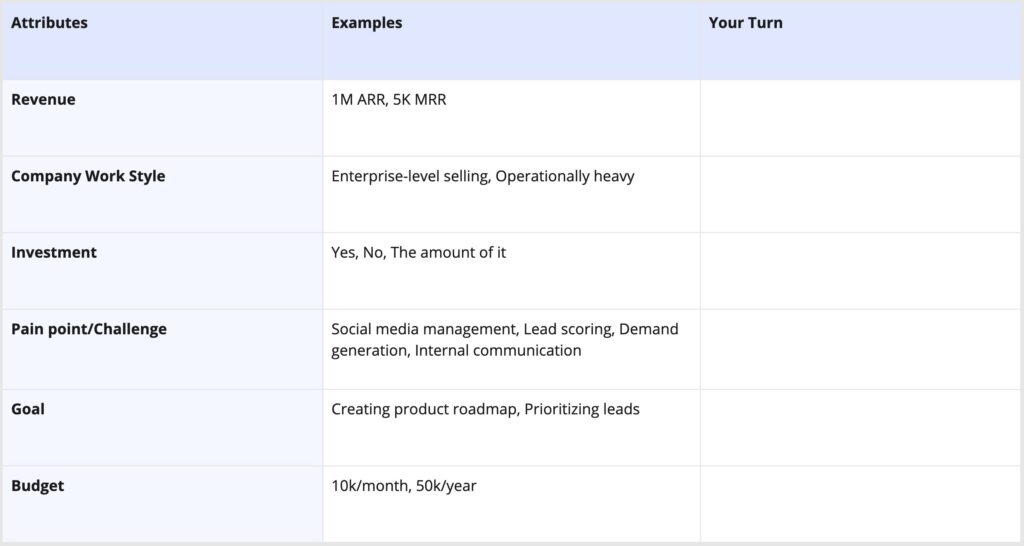
Buyer Persona/Customer Demographics
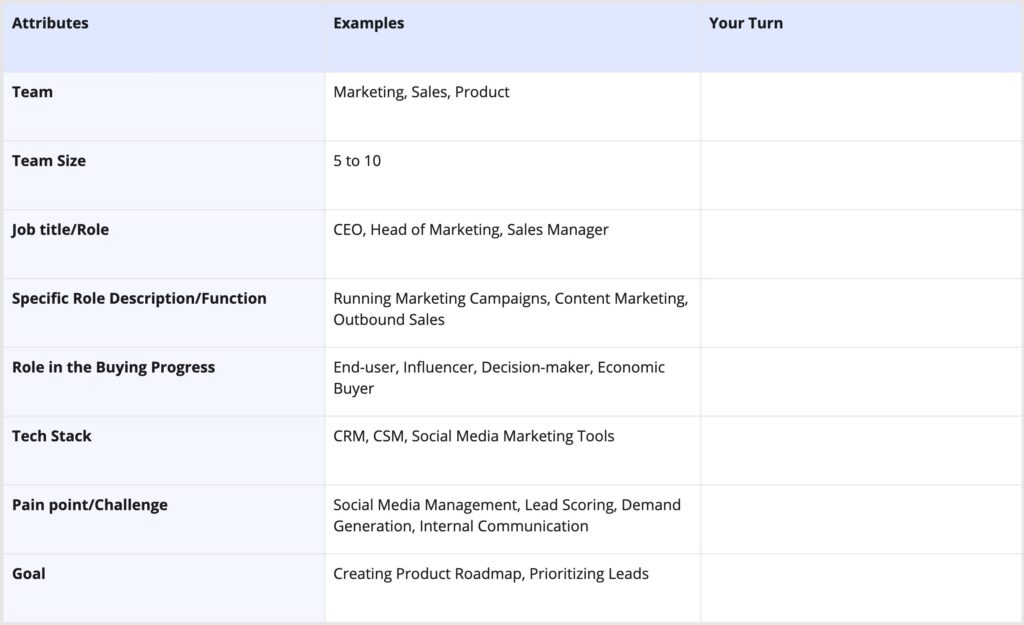
HubSpot’s Buyer Persona Template
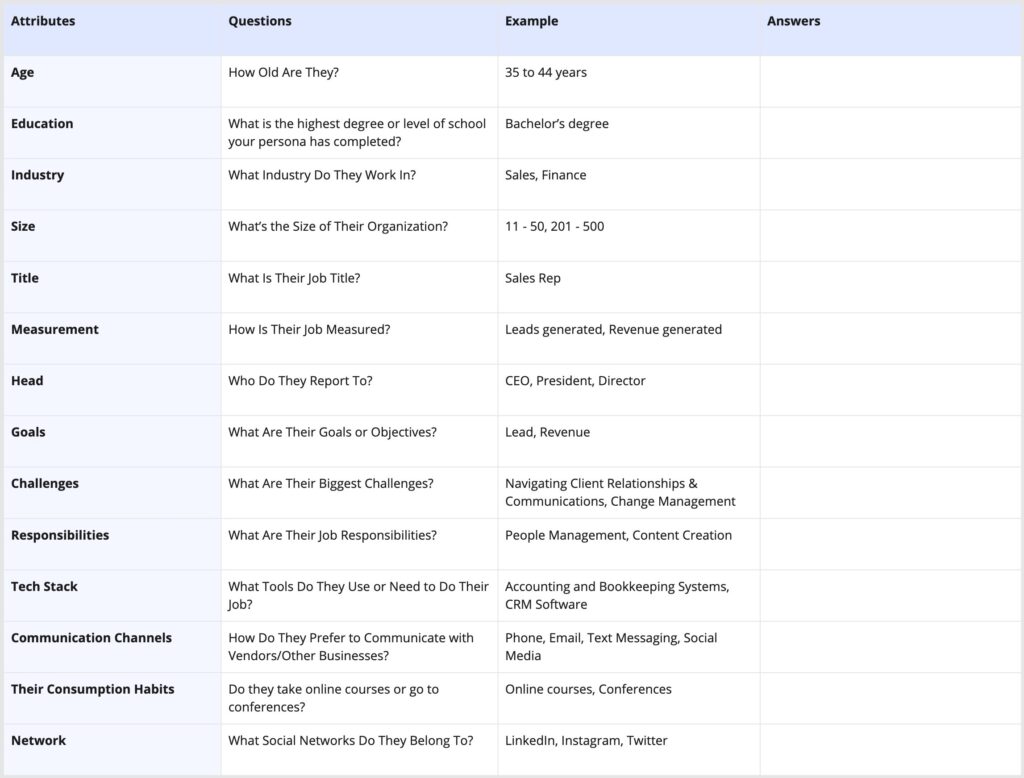
Gong’s Sales ICP Template
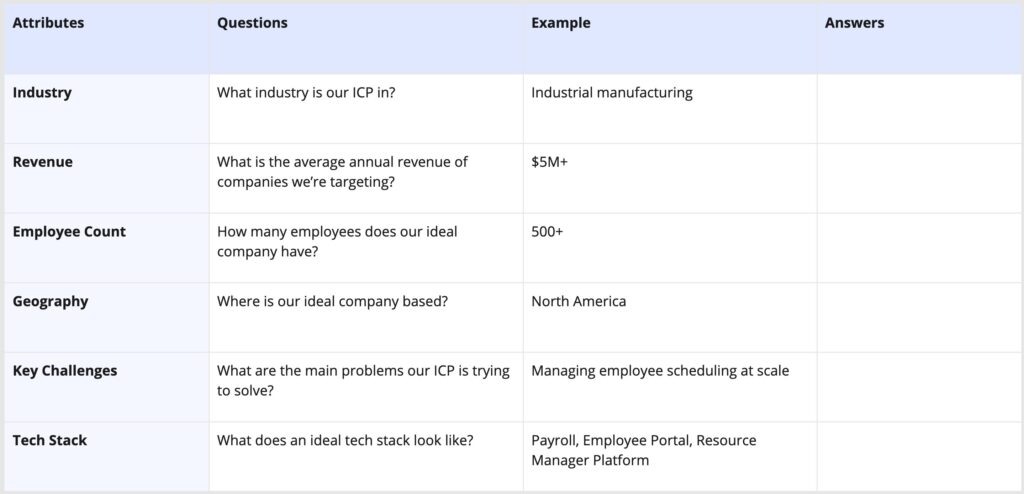
ICP Template for Different Campaigns, User Types, or Plan-Based Identification

*You can also enrich each segment by multiplying the titles in a company
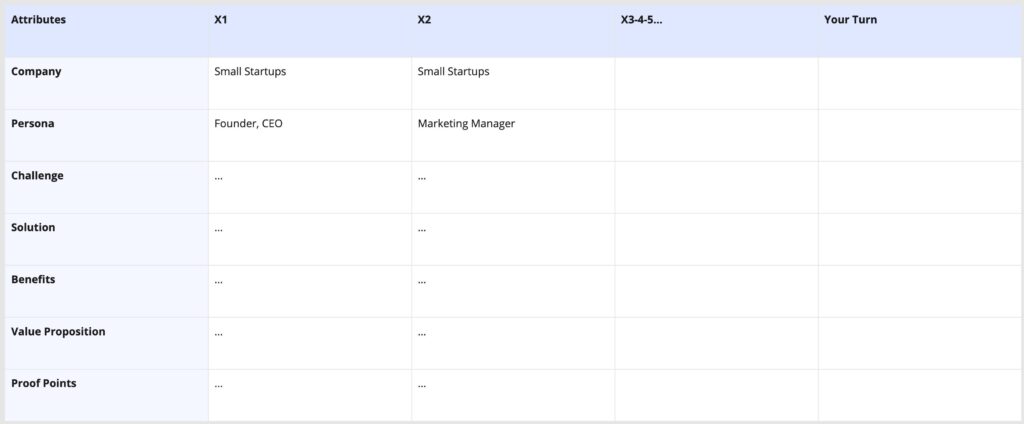
ICP Template from One of the Interviewers
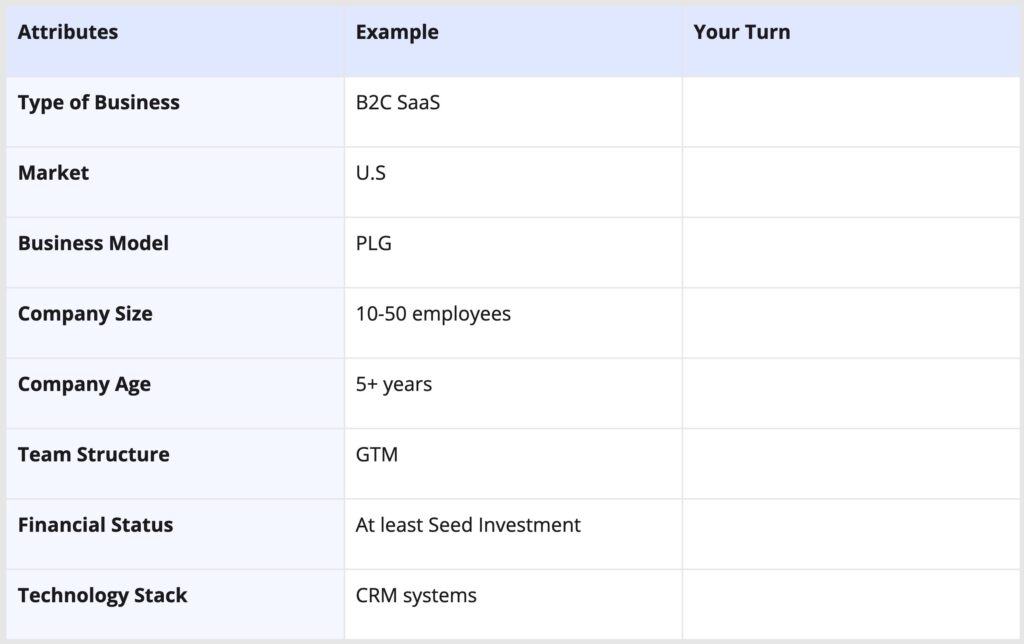
ProductLed’s User Canvas Template
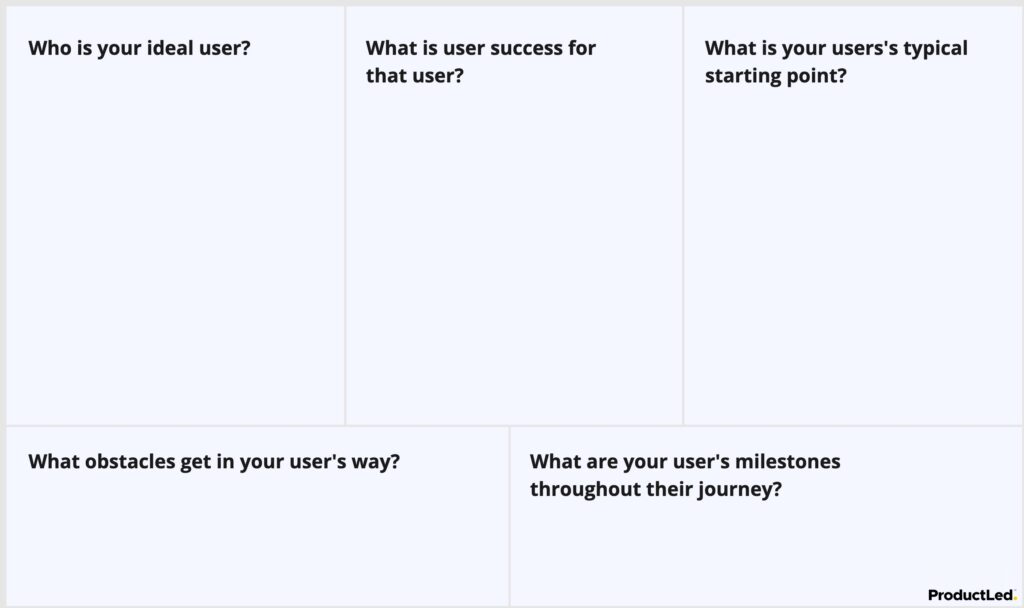
Part 6: Tools and Generators
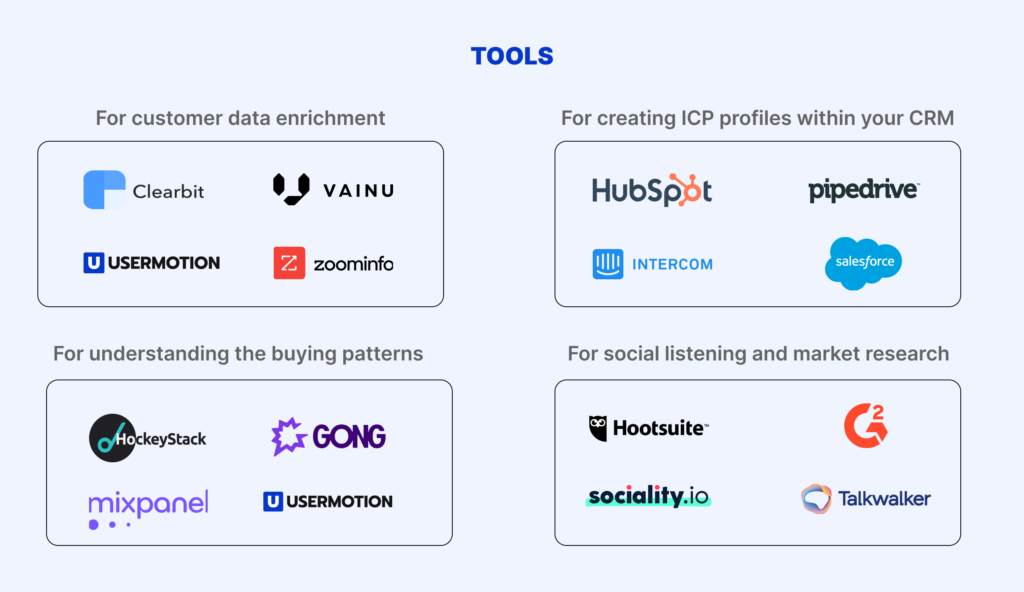
ClearBit
“Clearbit offers a range of tools to help you your their ideal customer profile research. It provides real-time data enrichment, risk mitigation, and lead scoring to help you understand and target your ideal customers effectively.”
Hubspot
For creating ICP profiles within your CRM, HubSpot does so:
“To create an ideal customer profile in HubSpot, you can use the “Ideal customer profile tier” property.
The ideal customer profile tier represents how close a company matches your ideal customer profile in three tiers. Companies that are Tier 1 should be a great fit for your products/services, where Tier 3 might be acceptable, but low priority.
You can edit this property to align with your business strategy and assign values manually or use a workflow to automate the process. For more detailed instructions, you can refer to the HubSpot knowledge base.
HubSpot also offers a free service, named Make My Persona to create a customer profile. It has a very simple, visualized, and fun process, consisting of 7 steps, to create a buyer persona. You can download it after completing it.”
HockeyStack
“HockeyStack offers reporting to help you understand the buying patterns of your customers, including metrics like customer lifetime value, retention rate, customer churn, and monthly revenue growth, and refine your ideal customer profile accordingly.”
Align
For refining your ICP, you’ll need customer insights in hand, eliminated, segmented and systematized:
“Align is a platform which can integrate with your CRM, Support Tool and other Feedback Sources and automatically systematizes any insights.
It then enables you to explore the findings across different parameters, including deal size, segment etc. to be used to understand if the relevant insights are coming from your ICP, and creates a chance to refine your ICP with the data you get.”
G2
Reviewing the customer reviews of your competitors is gold:
“G2 can become a good tool for improving the understanding of your ICP. Go to your competitors page, export all customer reviews, eliminate the data and analyze the outcomes.”
Hootsuite
Use social media listening to identify ideal customer profiles and gather insights into their interests and preferences:
“Hootsuite helps you with seeing what people are saying about your target market and topics.”
Gong
“With Gong, you can discover common properties of customers and use its AI algorithm to discover sales patterns.”
Role of AI
AI is everywhere and creating and refining ideal customer profiles is no exception.
Training your AI model
AI can identify common points in your customers, and help you with your ICP:
“When you put some customer data, a well-trained AI model produce the insights you need to identify your customer profiles.
You put:
- Demographic data
- Behavioral data
- Customer feedback
You get:
- Commonalities
- Identifiers
- Variations
By this way, AI models analyze what you’ve put, and generate some useful results to use in your ideal customer profile.”
Use ChatGPT for ICP
I’ve encountered an interesting experience on Reddit, about using some specific ChatGPT prompts to create your ICP (Creating your ICP- with a little help from ChatGPT):
“Using ChatGPT for creating ICP is not 100% true and perfect, but you can at least use it as a starting point.
It helps refine the understanding of the ICP and subsequently in building out sales and marketing programs by identifying relevant personas and pain points.
Initial Training with Prompt 1
- Start with Prompt 1: Copy and paste Prompt 1 into ChatGPT. “I’m going to work with you and train you on building our ideal customer profile (ICP). I will provide some basic parameters and you will respond with your suggestion for the ICP. I will respond with agree or disagree with your response.”
- Provide Basic Parameters: After the bot responds, provide some basic parameters about your ICP.
- Iterative Refinement: Review the bot’s suggestion for the ICP and respond with “agree” if it’s correct or “disagree” if it needs refinement.
- Continue the Exercise: Keep refining the bot’s understanding by providing more information or clarification until you can respond with “perfect ICP”.
Refinement with Prompt 2
- Introduce Prompt 2: Once you have reached a basic understanding of Prompt 1, introduce Prompt 2 with more specific information about your company and services. “Your clients’ industry is 80% nonregulated clients, and 20% regulated clients, such as healthcare or government. Your MSP company size is 3-10 staff; your location is solely US-based. Your target budget per client is less than $2000 per month per client.”
- Further Refinement: Review the bot’s refined ICP and continue to provide more details or corrections as needed.
- Achieve Perfect ICP: Continue this refinement until you find the “perfect ICP”.
Summarize and Identify Personas and Pain Points
- Ask for Summary: Once the “Perfect ICP” is achieved, ask ChatGPT to summarize the ICP.
- Identify Personas and Pain Points: Move on to the next part of the process, which is identifying personas and pain points for that ICP. Ask the bot to suggest possible personas and pain points based on the refined ICP.”
Part 7: Identify Intent Signals
There are some intent (or buying) signals you can identify from your data analysis, patterns, and feedback to understand the willingness and likelihood of your ICP to use and buy your product.
I wanted to talk about these signals in a separate header because they are as important as your ICP. These signals add more weight to ICP scores, showing the chances of turning a potential customer into an actual one and indicating they need what you’re offering right away.
Before moving forward with the possible signals you can track, why are these signals the real things? Well, they help with:
- Identifying PQLs, MQLs, and SQLs.
- Seeing who’s really in need of your product, allows you to act at the right time.
- Knowing who’s likely to buy helps you allocate your resources more efficiently, focusing on leads that are more likely to convert.
- By understanding what your customers need, you can tailor your approach, making your interactions more meaningful and engaging.
- Refining your ICP based on the customer buying signals.
Now, some examples of these signals can be: (Here is your B2B Buying Signals sheet (Page 4) to use in your business.)
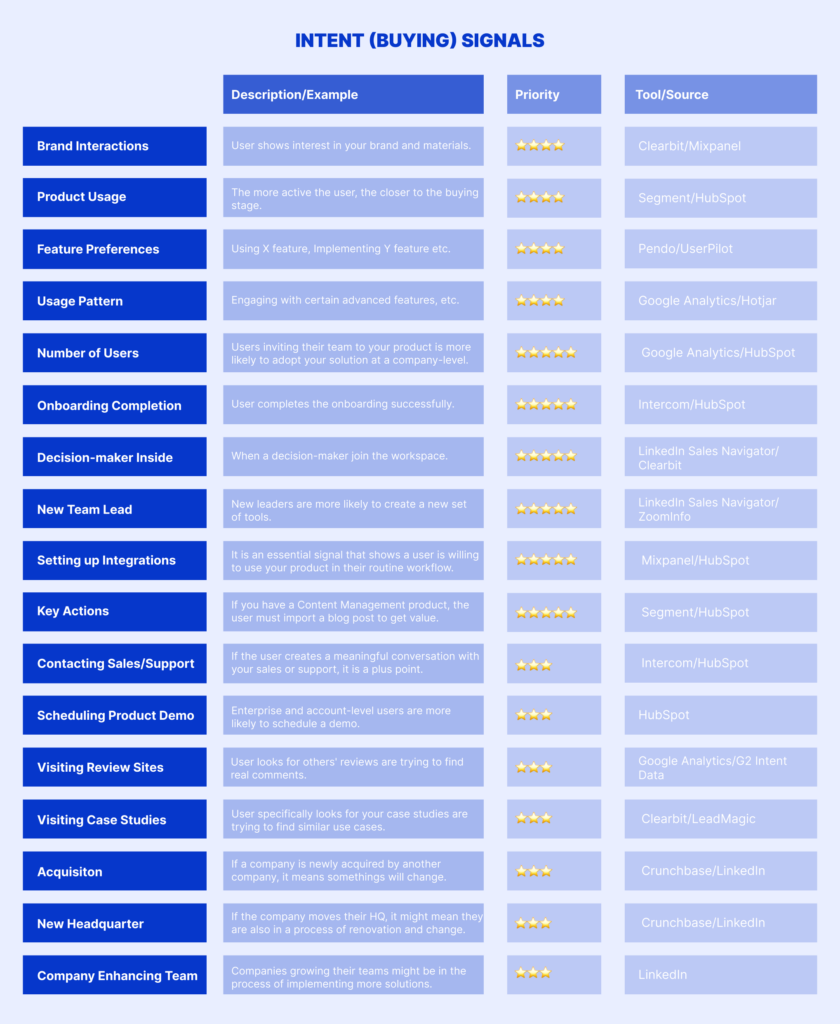
- Brand Interactions (The user shows interest in your brand and materials are more likely to buy. The level of the interaction is important here. Website, Social Media Engagement, etc.)
- Product Usage (The more active the user, the closer to the buying stage. Daily, weekly, active for 1 hour, etc.)
- Feature Preferences (Using X feature, Implementing Y feature, etc.)
- Usage Pattern (Engaging with certain advanced features, etc.)
- Number of Users (Users inviting their team to your product are more likely to adopt your solution at a company level.)
- Onboarding Completion ( Users who completed the whole onboarding or have successfully completed the onboarding steps are more ready to implement your solution.)
- Decision-maker Inside (When a decision-maker joins the workspace, it means that the product passed from the influencer/user persona to the buyer persona.)
- New Team Lead (New leaders are more likely to create a new set of tools.)
- Setting up Integration (It is an essential signal that shows a user is willing to use your product in their routine workflow.)
- Key Actions (You need to identify your key actions that give value, and if a user takes that action, it is the best signal.)
- Contacting Sales/Support (If the user creates a meaningful conversation with your sales or support, it is a plus point.)
- Scheduling Product Demo (Enterprise and account-level users are more likely to schedule a demo.)
- Visiting Review Sites (A user looks for others’ reviews are tries to find real comments.)
- Visiting Case Studies (A user specifically looks for your case studies and is trying to find similar use cases.)
- Acquisition (If a company is newly acquired by another company, it means some things will change, and therefore they are testing your product.)
- New Headquarter (If the company moves their HQ, it means they are also in the process of renovation and change.)
- Company Enhancing Their Team (Companies growing their teams might be in the process of implementing more solutions.)
*Please note that these signals are meaningful when the user/account is matching with your ICP. Additionally, these signals can vary from business to business, so it is your role to choose the relevant ones.
How to Identify These Signals?
As I shared above, you can keep Excel sheets or Notion tables, but to be honest, it will require too much time and effort to put them together.
Especially when there is too much data we cannot keep track of.
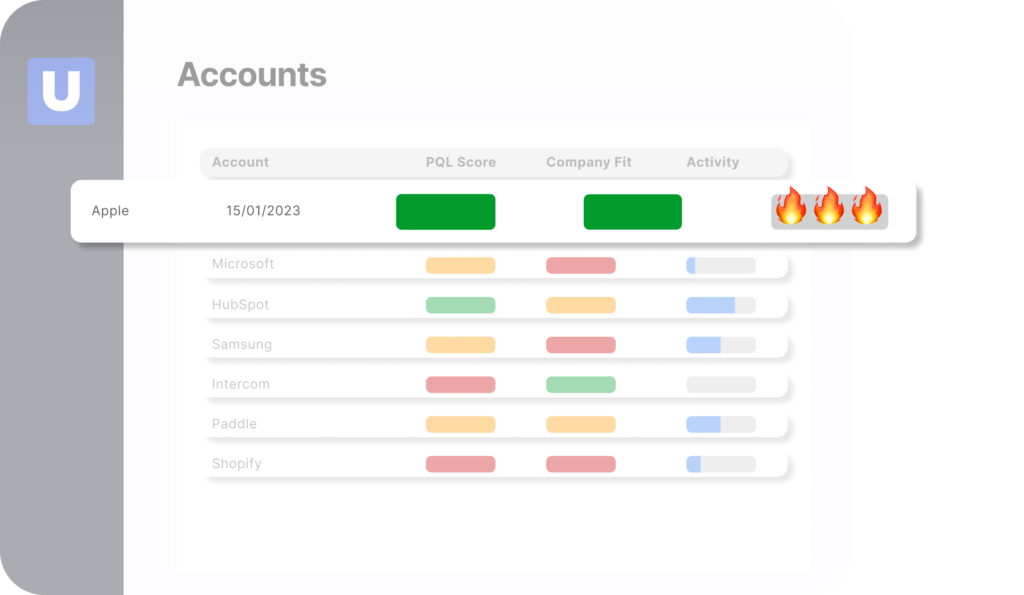
There are pretty promising tools out there, for detecting these B2B intent signals and prioritizing your leads, and UserMotion is one of them.
Buying Signals and Customer Scores
UserMotion helps you identify these buying signals without spending time, effort, and money. It collects user behavior, patterns, and specific signals and its AI algorithm adds more weight to ICP scores, letting you see who’s more interested and who’s just browsing.
High Potential Customer Alerts
Every time a new signal is detected and makes a lead close to buying, it notifies you via your communication channel, like Slack. Decision-maker signed up? You’ll know immediately and take action with an expert-made sales playbook.
Refine your ICP with Historical Data
UserMotion’s AI algorithm also helps you identify the common characteristics and behaviors of your best customers so that you can refine your ICP based on historical data and insights from your won deals.
🗣 Advice from Leaders
- Narrow down your ICP. Focus on company attributes at first, and get as specific as possible.
- Add unique attributes and characteristics for further specification of your ICP.
- Identify your user and buyer persona to understand who really is your lover, and who is giving their precious money.
- No worries, your first ICP is not meant to be your last.
- Pay attention to your super users while refining your ICP.
- Do more customer interviews. More and more.
- Keep testing; pay attention to the signs and metrics.
- We all do have 0 months. Do not push hard. If there is someone willing to buy from you, but not fit in your ICP, still sell.
- Out of a cohort of 10, at least 1 person might have gotten some value. Let’s call them a “golden goose”. Now you go and find more than 10 people that fit the “golden goose” profile.
- Do we need multiple ICP profiles? Not every time. Go for simplicity and try to go with the fewest number of ICPs as possible.
- Always analyze intent (buying) signals to create and refine your ICP, not just for closing a single deal.
- The concept of an ideal customer profile can be subjective and vary depending on the industry.
📚 Further Study
- How to Identify Your Ideal Customer Profile by Lenny’s Newsletter
- Ideal Customer Profile (ICP): How to Create a Comprehensive Customer Profile by Mykpono
- The Mom Test by Rob Fitzpatrick
- Demand-side Sales by Bob Moesta
- Obviously Awesome by April Dunford
- How to Scale Your Business with Your Ideal Customer In Mind by ClearBit
Frequently Asked Questions
What is critical in identifying an ideal customer profile?
It’s crucial to understand customer demographics, interests, needs, and behaviors to identify your ideal customer profile effectively. This involves analyzing their values, buying patterns, and interactions with your product or service.
What is an ideal customer profile in B2B?
An ideal customer profile in B2B is actually an ideal account profile, as it is more about account-level identification in B2B businesses. So, you can think of it as an imaginary representation of your dream customer “company” that is more likely to buy your product.

